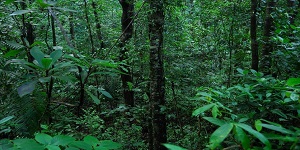Incredible Forests of India
By :
Incredible Forests of India
March 25, 2022
Forests are the ecological backbone of the earth. These are a source of livelihood and sustainability.
Forestry has been a major contributor to the economy of India. They are a vital aspect for development and it is essential to restore and conserve them for ensuring sustainability and climate resolve. As per the Forest Survey Report of 2021, in the last two years, the tree cover in India has increased by 2,261 sq km.
Following is a State-wise forest coverage of India, each with its unique terrain and biodiversity.
Madhya Pradesh

The Ratapani forest of Madhya Pradesh
Madhya Pradesh has the largest forest cover in the country. The rural and urban population of the State derive their livelihood from the dense forests of the area. There are 25 Wildlife Sanctuaries, 9 National Parks, 5 Tiger Reserves, 2 Biosphere Reserves in these forests. Madhya Pradesh has a moderate subtropical climate and receives annual rainfall between 800 mm to 1,800 mm (India’s national average being ~1803 mm per year). The terrain of these dense and green forests has a fine network of rivers namely Chambal, Narmada, Tapi, Betwa, Ken, Son, and Mahi. The forests are home to Tigers, Panthers, Gaur, various aquatic and terrestrial species.
Arunachal Pradesh

Sub-Tropical Pine Forest of Arunachal Pradesh
‘The Land of Rising Sun’, Arunachal Pradesh has rich flora and fauna diversity. From the snow-covered mountains of the Eastern Himalayas (North) to the plains of Brahmaputra Valley (South), the State of Arunachal Pradesh has a flourishing range of forests. The vibrant tribes of Arunachal Pradesh dwell in these magnificent sanctuaries, the forests and wildlife are of great significance to them. Tropical Evergreen, Semi-Evergreen, Deciduous, Pine, Temperate, Alpine, and Grassland are some of the significant forest types found in the State. Forests are one of the main sources of livelihood for inhabitants of Arunachal Pradesh, and the State has some of the richest bio-geographical diversity in the eastern Himalayan region.
Chhattisgarh
Chhattisgarh is a culturally rich State with stunning waterfalls, lush green forests, carved temples as well as rare and dynamic wildlife. The State is heavily forested and was constituted from a part of Madhya Pradesh back in the year 2000.
There are 3 National Parks and 11 Wildlife Sanctuaries in the forests of Chhattisgarh. These forests are classified into two broad groups, Tropical Moist Deciduous Forests and Tropical Deciduous Forest, which are further diversified into 21 forest types. Sal and Teak are the two major tree species found in the forests of this State. Mineral resources such as coal, iron, bauxite, limestone, corundum, tin, and others are abundant in the State and are mostly found in forest areas. Approximately half of the villages in the State are within a five-kilometer radius of forests.
Karnataka

The Evergreen Forests of Karnataka
Karnataka is a land of culture, heritage, wildlife, and nature. The State has many tourist attractions, magnificent temples, and beaches. The forests of Karnataka are a combination of evergreen and deciduous forests. The State has a variety of forest vegetation and a wide range of floral diversity. Around 60 forests of Karnataka are located in the Western Ghats, which is one of the mega-biodiversity regions of the world. The forests in the Eastern Plains are rich in a variety of medicinal plants.
Assam

Tea plantation of Assam
Assam offers an unparallel experience in terms of heritage and culture. The North-East State of Assam has mountains, valleys, and a detailed river system in place, making it a rich hub of natural resources. Wild elephants, Tigers, and Leopards are commonly found in the forests here. Assam is widely known for its tea plantations and single-horned Rhinoceros. The State has a subtropical climate, with temperatures ranging from 5 to 32 degrees Celsius and annual rainfall ranging from 1,500 to 3,750 millimeters (India’s national average being ~1803 mm per year). Assam's forest area is around 26,832 sq km, which includes 18 forest types divided into five broad groups Tropical Evergreen, Tropical Moist Deciduous, Tropical Semi-Evergreen, Tropical Dry Deciduous, and Sub-Tropical Pine Forests. The diverse range of forests in Assam is rich in both commercial and household resources such as wood, bamboo, cane, medicines, fruits, and fiber.
Uttarakhand

The dense and green forests of Uttarakhand
Forests and the future
According to the ‘India State of Forest Report 2021’, researched and presented by the Forest Survey of India, 17 States/UTs have more than 33% of their land covered by forests. Such vast forest coverage makes conservation of these forests even more critical to ensure the sustainability goals of the country of decreasing carbon emissions by 1 billion tonnes by 2030 and achieving the target of net-zero emissions by 2070.